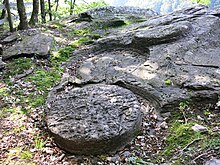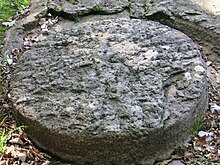Mill quarry Mels
The Mels mill quarry ( Runggalina quarry ) is an open-air museum complex on Geoweg Mels , which is located on the area of a disused quarrying site for millstones from Verrucanogestein ( Melsersteine ) on the Castels hill near Mels in the canton of St. Gallen in Switzerland .
history
The reddish-purple coarse-sand to finely brecciated Sernifite (Verrucano) were recognized as suitable for the production of hand mills as early as the Neolithic or Bronze Age. The oldest hand mills found from Mels stone date from this time. A round millstone with a diameter of half a meter from Roman times was excavated on the Castelshügel. The millstones were used for grain, fruit. Gypsum, cement and glaze mills made.
The Mels rocks consist of hard components in a softer matrix. As a result, they can hardly be ground smooth by the grinding process. During the grinding process, small pieces of the matrix loosened, exposing the hard grains, which broke off over time, leaving the rock rough. For grain mills, the grooves had to be sharpened regularly.
In the 17th century the Mühlsteinhauer were organized in guilds. In 1689/90 the Eight Old Places (excluding Bern) issued letters of freedom for the Mühlsteinhauer Society.
production
In 1830–1850, millstones were broken all over the Castels hill. The stone was drawn on the rock with a compass and on this line with the cocked hat broken and the finished millstone with iron bite cleaved from rock. In the last operation every second stone was broken. The diameter of the millstones was 90 to 120 cm. The floor stones for flour mills were 40-60 cm thick, the runner stones 20-40 cm. In the 1880s and 1990s, a millstone one meter in diameter and per inch (approx. 3 cm) thick cost 4 marks (approx. 5 francs). A stone cutter earned 5 francs per day, a stone sprinkler 3 and a henchman 2 francs. The stone carvers came from Italy, sprinklers and henchmen were locals.
distribution
In the first half of the 19th century - before the railway was built - the Mels millstones were sold in Chur, Rheineck, Rorschach, Bregenz and Friedrichshafen and exported to Prussia and Hungary.
At the end of the 19th century, most of the Mels millstones were picked by stone lords from Germany in the Runggalina quarry, bought and exported to Africa. Each time 15 tons of millstones, which could be placed in two railway cars, were set up for the stone removal. The millstones were made wet and knocked with a hammer to discover any mistakes. In March 1915 the last two wagonloads were sold.
Open-air facility
The well-preserved millstone quarry on the Castelshügel shows millstones carved on the rock in various stages, on which the mining techniques can be understood. Based on the historical description on the display board at the millstone quarry, the significance of this important branch of industry for the municipality of Mels and the region at that time can be assessed.
literature
- David Imper: Rocks, raw material extraction and stone processing in the Sarganserland . To the opening of the Geoweg. Self-published, Mels 1996
Web links
Individual evidence
- ↑ David Imper: Rocks, raw material extraction and stone processing in the Sarganserland . To the opening of the Geoweg. Self-published, Mels 1996, page 31
Coordinates: 47 ° 2 '58.1 " N , 9 ° 24' 43.1" E ; CH1903: 749930 / two hundred twelve thousand eight hundred and twenty-three



